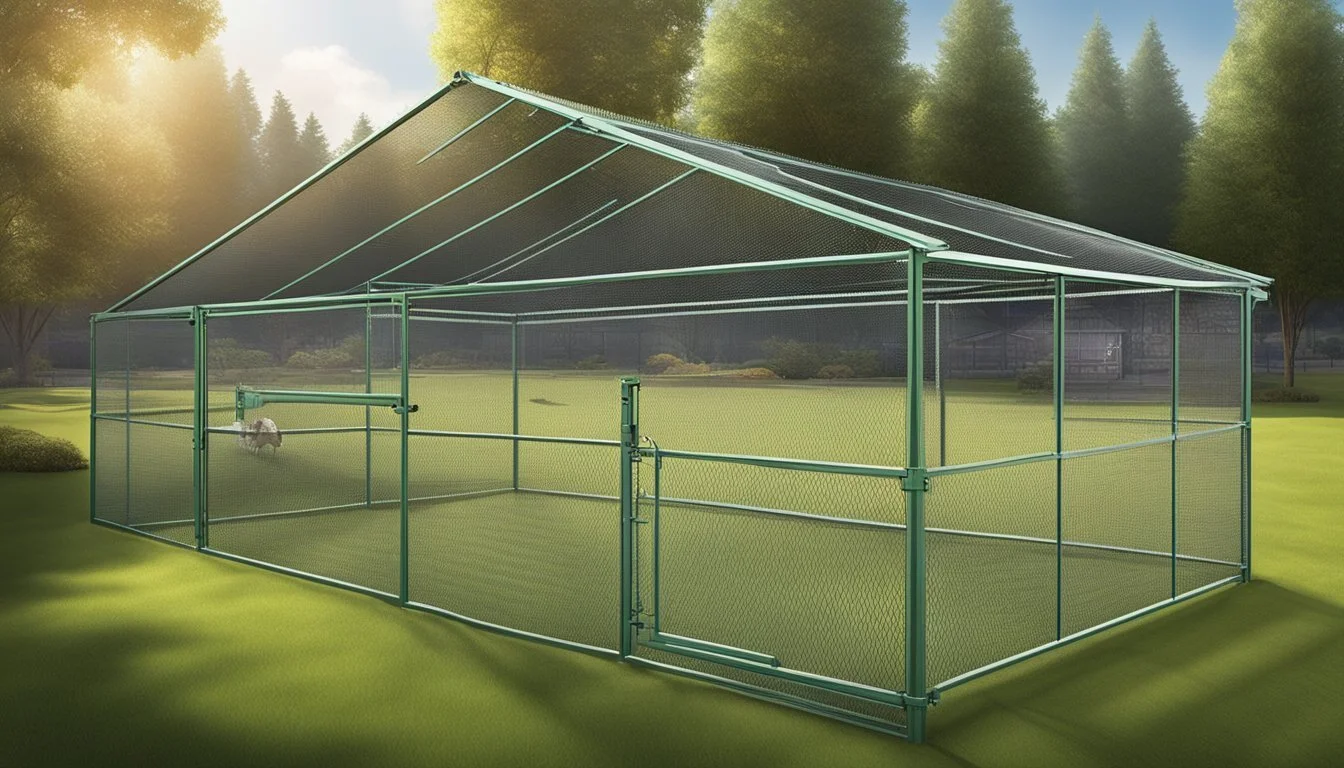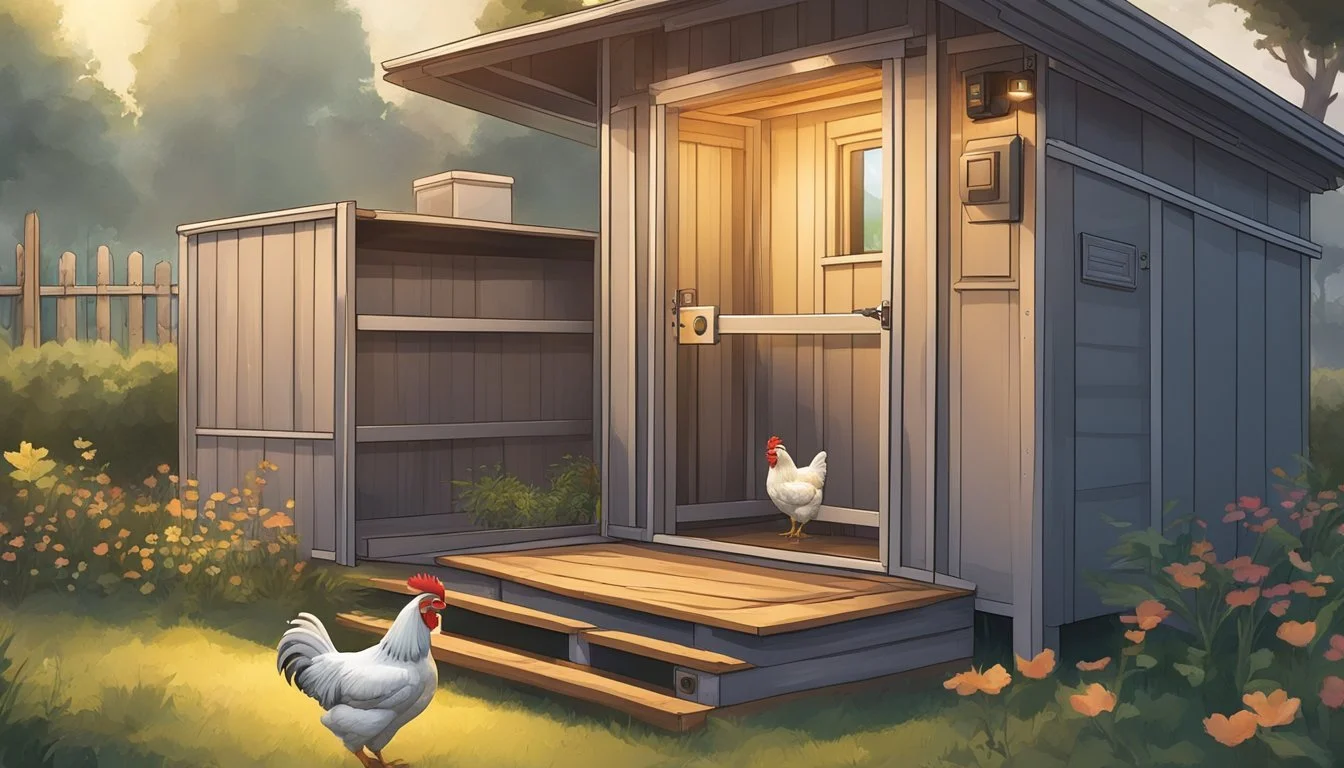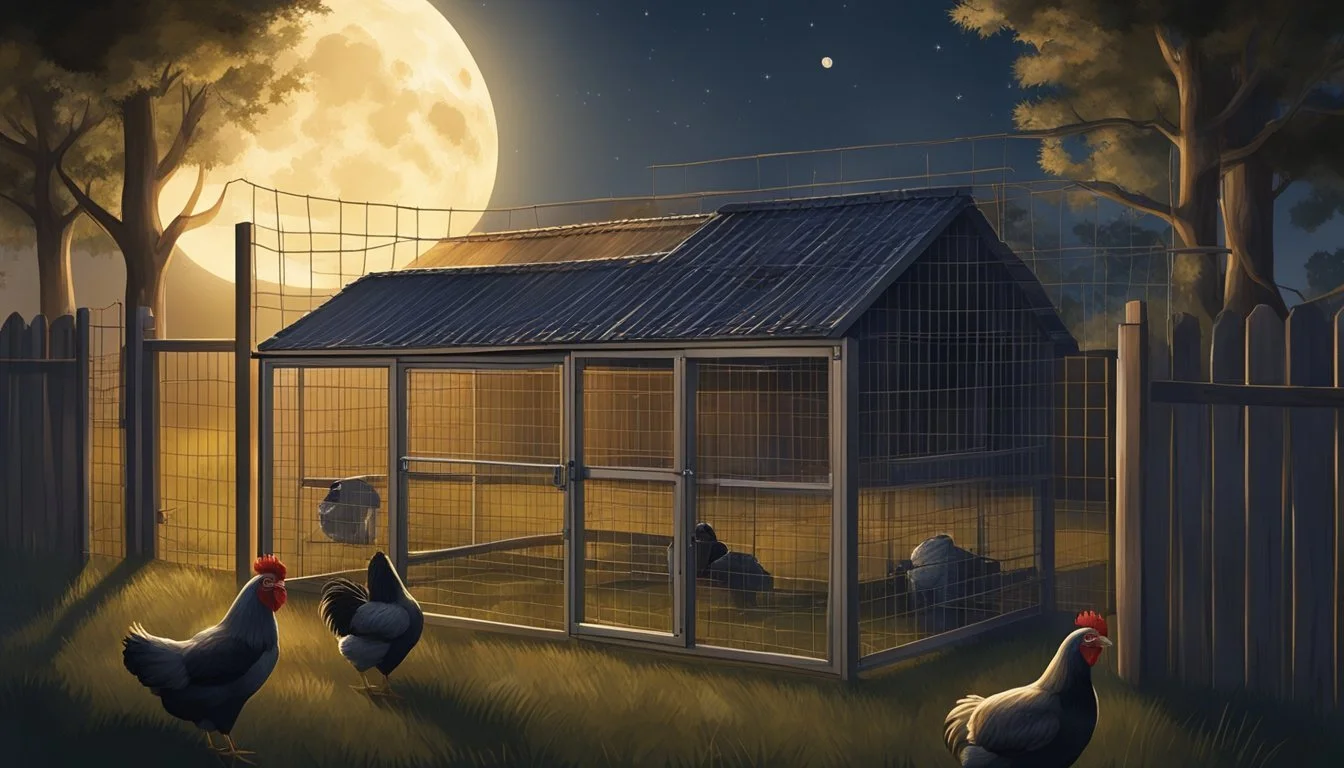How do I Keep My Chicken Coop Secure at Night
Essential Tips for Protection
Ensuring the safety of a chicken coop during the night is a critical concern for poultry owners. Predators are often more active after dark and can pose a significant threat to a flock if proper precautions are not taken. A secure coop serves as the first line of defense against these nocturnal threats, protecting chickens from potential harm. There are proven strategies to reinforce the coop, such as fortifying the structure and employing various security measures that work to deter or altogether prevent predator intrusions.
One effective method to safeguard a chicken coop is to focus on its structural integrity, including the reinforcement of doors, walls, and flooring. It's essential to use sturdy materials and ensure there are no gaps or weaknesses through which predators could gain access. Adding extra layers of protection, such as hardware cloth around the perimeter, can also be an effective deterrent. Furthermore, the positioning of the coop plays a role in its safety; strategically placing the coop away from wooded areas can reduce the risk of predator attacks.
Beyond the physical structure, incorporating nightly routines can be vital for coop security. For example, locking the chickens up at night is an indispensable habit that adds an additional layer of safety, keeping the flock out of harm's way when they are most vulnerable. This practice, combined with the installation of motion-sensor lights or noise-making devices, can startle and ward off would-be predators, ensuring that chickens remain safe and sound until morning.
Understanding Chicken Coop Predators
Ensuring the safety of backyard poultry requires knowledge of the variety of predators that pose risks to chicken coops at night. Recognizing potential threats and understanding their behaviors are crucial steps in safeguarding chickens.
Identifying Common Predators
Predators that commonly threaten chicken coops include mammals and birds. Each predator has unique characteristics and methods for attacking poultry:
Foxes: Known for their cunning and agility, foxes can dig and even open latch doors.
Hawks and Eagles: Birds of prey typically strike from above during daylight hours.
Raccoons: These adept climbers and handlers can open simple closures and access small openings.
Owls: Silent nocturnal hunters that can snatch chickens in the dark.
Coyotes and Wolves: Canines that can tear through weak structures and dig underneath barriers.
Rats and Snakes: Smaller predators that prey on eggs and chicks, often squeezing through tiny gaps.
Cats, both domestic and feral: May prey on smaller or younger birds.
Bears: Capable of demolishing coop structures if enticed by the smell of feed or chickens.
Weasels, Minks, and Fisher Cats: Small but relentless predators that can slip through very small spaces.
Bobcats and Badgers: These predators utilize strength and stealth, and can dig or break into poorly secured coops.
Predator Behavior and Risks
Understanding predator behavior is essential for implementing effective security measures:
Nocturnal vs. Diurnal: Predators like owls and coyotes are active at night, while hawks and eagles hunt during the day.
Digging and Climbing: Foxes, raccoons, and bears may try to dig under or climb over barriers.
Strength and Cunning: Bears and bobcats can break through weak defenses, while raccoons may manipulate closures.
Stealth Attacks: Weasels and minks often kill silently, sometimes not consuming their prey on-site.
Feeding Habits: Some predators target eggs and chicks, such as rats and snakes, rather than adult chickens.
By considering these specifics, one can design a more secure chicken coop to protect against nocturnal and diurnal threats effectively.
Coop Construction: Basics for Security
The strength of a chicken coop during the nighttime hinges on robust construction techniques. Knowing which materials to use and how to construct floors, walls, and roofing ensures that poultry remains protected from nocturnal predators.
Choosing the Right Materials
For maximum security, the selection of materials for a chicken coop is critical. The optimal material for fencing is welded wire or hardware cloth, as these are more resilient than chicken wire, which predators can easily break through. The use of sturdy, durable materials not only discourages predators but also ensures longevity of the coop.
Building a Solid Floor
Constructing a solid floor inside a coop greatly reduces the risk of predator intrusion from below. A firm, wooden floor elevated above the ground assists in preventing decay and deterring digging animals. It is often advised to reinforce the floor with hardware cloth to safeguard against burrowing predators.
Secure Walls and Roofing
Walls should involve tightly sealed siding with no gaps or weak points. Using hardware cloth or welded wire mesh can significantly decrease the risk of predator entry. For the roof, one must ensure it is fully enclosed and is able to withstand the elements, which adds another layer of protection for the chickens housed within. It is essential to avoid using chicken wire for the roof, as it is not secure against larger, more aggressive predators.
Fortifying the Coop
Ensuring a chicken coop is secure at night involves a multi-faceted approach where every potential entry point is strengthened against predators. Focusing on the doors and windows is crucial, as these are often the primary areas of vulnerability.
Reinforcing Doors and Locks
Doors must be constructed from sturdy materials resistant to animal scratching or force. Installing heavy-duty padlocks can provide an additional layer of protection. Moreover, it is advisable to equip doors with a lock system that cannot be easily manipulated by raccoons and other intelligent predators. Locking mechanisms should be checked regularly to ensure they are functioning correctly.
Securing Windows and Vents
Windows and vents are necessary for proper ventilation but can also serve as access points for predators. Covering these openings with hardware mesh or strong screens is essential to prevent animals from reaching inside. One should ensure the mesh is fine enough to stop smaller pests and is secured firmly to the coop's structure. Lockable window latches provide an added security measure, ensuring that windows cannot be pried open during the night.
Defensive Measures
Ensuring the security of a chicken coop at night requires implementing a range of protective strategies. Effective defensive measures include robust fencing, strategic lighting, and the use of livestock guardians, each playing a vital role in deterring predators and safeguarding poultry.
Employing Fencing Options
Fencing is the first line of defense against predators. Solid barriers such as welded wire or hardware cloth should envelop the coop, including burying them underground to thwart digging attempts. It is crucial to bear in mind that materials like bird netting provide an additional layer of safety for the top of the run, preventing aerial predators from swooping in.
Using Lighting to Deter Predators
Predators are often deterred by well-lit environments. Installing motion-activated lights around the coop can dissuade nocturnal threats by illuminating the area unexpectedly, making predators visible and disrupting their approach. Consistent lighting also serves as a deterrent, creating a perception of human activity and security that many predators will avoid.
Livestock Guardians
Livestock guardians, such as dogs, donkeys, or llamas, serve as an active protective measure. These guardians are specifically trained or have innate protective instincts to ward off potential threats. They not only offer physical protection but their presence and scent marks can discourage predators from considering the coop as a target.
Maintaining a Secure Environment
A chicken coop's security at night hinges on diligent maintenance and hygiene practices. These preventative measures are crucial for safeguarding against potential threats and ensuring the health of the flock.
Regular Inspections and Repairs
Maintenance is pivotal in a chicken coop’s security. Owners should inspect their coop regularly for any signs of wear or damage. Particular attention should be paid to identifying holes or weak spots that could invite predators. Any discovered vulnerabilities require prompt repair to fortify the coop. Simple steps include:
Checking for gaps or cracks in the coop walls.
Ensuring all doors and windows close securely.
Examining locks and latches for proper functioning.
Reinforcing the coop's structural integrity if needed.
Coop Cleanliness and Hygiene
Maintaining cleanliness within the coop is as vital as structural upkeep. A clean environment deters pests, which may carry diseases, and reduces the risk of illness in poultry. Regular cleaning schedules should be in place to manage waste and prevent the buildup of harmful bacteria. Key areas to focus on include:
Removing droppings and replacing bedding material.
Disinfecting feeders and waterers to prevent contamination.
Allowing adequate ventilation to keep the air fresh and clean.
An orderly coop is a deterrent to pests and predators and provides a healthy living space, crucial for a chicken's wellbeing.
The Chicken Run: Enhancing Safety and Security
Ensuring the safety of a chicken run is fundamental to keeping predators at bay and providing a secure environment for the flock at night. Appropriate fortification and strategic placement of the coop contribute greatly to the overall security of the chickens.
Securing the Chicken Run Area
To effectively secure the chicken run area, one must focus on both the perimeters and the base. Installing netting over the top of the run can prevent aerial predators from swooping down. The sides should be reinforced with sturdy hardware cloth, with the mesh being fine enough to prevent the entry of smaller predators. It's advisable to bury this cloth at least 12 inches below the surface to deter diggers. Additionally, the inclusion of locks on all entry points further enhances coop security, ensuring that chickens remain safe throughout the night.
Reinforcements:
Top: Netting or wire secured over the run
Sides: Hardware cloth with fine mesh
Base: Cloth buried 12 inches underground
Entry points: High-quality locks
Considering Elevated Coops
An elevated coop provides several security benefits. Elevating the coop off the ground by a few feet can deter many ground-based predators and reduce the risk of rot and insect infiltration. The elevation should be substantial enough to prevent predators from jumping or reaching into the coop. A solid wooden floor prevents any possible entry from below. This design feature can be particularly effective if the location of the coop is prone to flooding or damp conditions, keeping the flock safe from environmental threats as well as predators.
Elevation Benefits:
Deters ground predators
Protects from rot and insects
Reduces flood risk
Automation and Technology
Integrating automation and technology is essential for enhancing the security of chicken coops at night. These modern solutions can significantly reduce the risk of predator attacks and provide peace of mind to poultry owners.
Automatic Coop Doors
Automatic coop doors are a pivotal component in coop security. These devices operate on timers or light sensors to open and close the door at appropriate times, ensuring that chickens are safely enclosed during the night. Benefits of an automatic chicken coop door include time savings and consistent protection, as it eliminates the need for manual operation.
Power Options: Typically powered by mains electricity or batteries, some doors also incorporate solar panels for energy efficiency.
Locking Mechanisms: Enhanced models may offer sophisticated locking systems that thwart intelligent predators.
Surveillance and Alarms
The incorporation of surveillance systems and alarms can bolster a coop's security network. These technologies act as deterrents and early warning systems against potential intruders.
Cameras: Placing cameras around the coop provides real-time monitoring and can often be accessed remotely via smartphones or computers.
Alarm Systems: Motion sensors or pressure-sensitive alarms can alert owners if unusual activity is detected around the coop.
Deploying a combination of these automation technologies can substantially improve the nighttime security of chicken coops.
Feeding and Watering Safety
Ensuring the safety of food and water supplies in a chicken coop involves strategic placement and secure storage to prevent contamination and deter predators. Proper management of these resources also contributes to the protection of the flock.
Secure Food Storage
Food should be kept in robust, airtight containers to prevent vermin and other predators from accessing it. Containers made of sturdy materials like metal can deter rodents, which are attracted to chicken feed. It is advisable to store the feed in a secure location such as a locked shed or another predator-proof area adjacent to the coop.
Water Safety
Water containers need to be clean, refilled daily, and free from contaminants. This is important both for the health of the chickens and to avoid attracting unwanted pests. Using water systems designed to minimize spillage, such as nipple drinkers or waterers with a lip, can prevent damp areas that could attract predators or cause health issues for the poultry.
Feeder and Waterer Placement
Feeders and waterers should be placed in areas where chickens feel safe and comfortable to access, ideally within the coop if space allows to limit exposure to predators during the night. In situations where it may be necessary to place them outside, they should be situated close to the coop and within a secure chicken run to minimize vulnerability to wildlife. During colder months, when chickens are less likely to venture outside, it might be beneficial to keep them inside to encourage eating and drinking.
Community and Support
When securing a chicken coop at night, a chicken keeper can derive immense value from engaging with the broader community. They can tap into a reservoir of shared experiences and specialized services that cater to the nuances of raising backyard chickens.
Leveraging Community Knowledge
Local farming communities and online forums are excellent resources for acquiring practical insights on coop security. Experienced poultry enthusiasts often share their proven techniques for predator-proofing coops. For instance, they may suggest specific locking mechanisms or construction materials that have worked effectively in their areas.
Community Workshops: Participation in community-led workshops can provide hands-on training in chicken coop security.
Online Forums: Platforms like BackYard Chickens offer a place for poultry owners to exchange tips and advice on a vast range of topics, including proactive nighttime coop practices.
Professional Advice and Services
For those seeking a more structured support system, professional advice and services can be indispensable. Poultry experts offer consultation services to assess and improve coop security.
Consultation Services: Local agricultural extensions or poultry specialists can conduct on-site evaluations to recommend safety enhancements tailored to individual needs.
Installation Services: Professionals can be hired to install advanced security systems, such as keyed locks or predator deterrents, which provide an extra layer of protection for the chickens.
Preparing for the Worst: Responding to Breaches
Securing a chicken coop involves not just preventative measures, but also a solid action plan for responding when defenses are compromised. A breach can leave chickens vulnerable and cause devastation, so it is critical to respond effectively and learn from each incident.
Immediate Actions After a Predator Attack
When a predator successfully breaches the coop, the immediate focus is on response and protection. Handlers should:
Secure the remaining chickens in a safe location.
Inspect the coop for injured chickens and provide prompt care.
Identify the entry point and temporarily seal it to prevent further attacks.
Handlers should act swiftly to mitigate damage while safeguarding the rest of the flock from further harm.
Learning and Adapting from Incidents
After addressing the immediate threat, the next steps are centered on learning and adapting. Handlers should:
Conduct a thorough investigation of the breach to understand how the predator infiltrated the coop.
Review and enhance coop security measures, such as reinforcing fencing or installing predator deterrents.
Adapting the coop's defenses in light of new information helps prevent similar breaches in the future, ensuring the chickens are well-protected at night.






